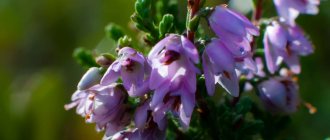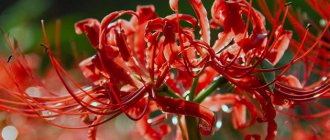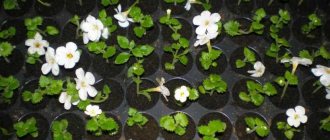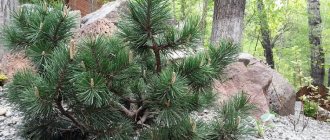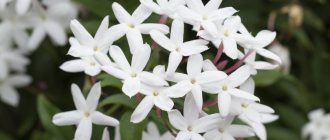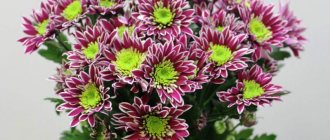In search of an original, beautifully flowering plant that could become a real decoration of the garden, it is worth paying attention to the calycanthus or chalyx flower (Calycanthus), which is just beginning to gain popularity among gardeners.
Representatives of the genus grow mainly in the southeastern regions of North America, and only one species comes from China. In the culture of the middle zone it is represented by three species of medium size.
These are deciduous shrubs up to 2-3 meters in height, forming a spreading, irregular crown shape. The bark and wood of almost all types of chapal flowers exude a very pleasant smell, reminiscent of camphor with a hint of spice.
Since time immemorial, it has been used to flavor dishes by the indigenous people of North America. The leaves and roots of the plant also smell, but less intensely.
The shoots are covered with elliptical leaves with pointed tips; young leaves are often pubescent. In early June, unusual dark red, white, pink or burgundy flowers with a strong aroma appear on the tops of last year's shoots.
Flowering lasts for a long time - until the beginning of autumn, but the greatest intensity occurs at the end of June and the first ten days of July.
After pollination, small brown fruits are formed, which do not have much decorative value, but contain viable seeds that have good germination for producing new calicanth seedlings.
Attention! Leaves and seeds of representatives of the genus contain toxic compounds and are poisonous
Calicant: description of the bush
Calicanthus shrub: plant photo
The international name of Calicant is Calycanthus froridus. The plant can grow up to two to four meters, olive-colored shoots form a lush crown consisting of large green oval leaves, the length of which is ten to fifteen centimeters. Young leaves have fairly dense pubescence; over time, it remains only on the underside of the leaves, while the top becomes smooth and gray-green.
During the first two months of summer, large burgundy flowers bloom on the Calicantha bush, emitting a pleasant aroma. When the plant fades, medium-sized fruits similar to water lilies ripen on it, and there are seeds inside them. In autumn the leaves gradually turn yellow.
3.Varieties:
3.1.Chinese calicanthus - Calycanthus chinensis
Deciduous shrub up to 3 m high with a spreading crown formed by abundantly branched shoots. The leaves are glossy, green, broadly lanceolate, arranged in opposite pairs on long, thin petioles. The surface of the leaf blades is covered with a branched network of veins. The flowers are white or pinkish, wide open, with round, thin petals and a yellow center, reaching a diameter of 10 cm.
↑ Up,
3.2. Florida Calicanthus - Calycanthus floridus
Dense deciduous shrubs up to 180 - 270 cm high with thin, branching shoots. The leaves are lanceolate, green, glossy, entire, on short petioles. When damaged, the leaf blades emit a pleasant smell. The flowers are single or collected in small apical inflorescences with dark burgundy, red-brown or greenish-cream petals, reaching a diameter of 5 cm. During the flowering period, which occurs in the second half of spring - early summer, the plant emits a very pleasant, fruity aroma.
↑ Up,
Calicant: outdoor care
Calicanthus grows well in our difficult climate and easily tolerates severe winter frosts. Like any plant, it needs special conditions, more about them.
Lighting
The plant loves good light, but at midday it is better for it to be in the shade. It is possible to plant calicanthus shrubs next to trees, but in this case you should choose neighbors with a fairly sparse crown so that the calicanthus gets the required amount of sunlight and is protected from direct sunlight.
Attention! Complete shade is a bad option for a shrub; it may not bloom.
Temperature
The calicanthus plant can take root well in both cold and warmer conditions. If you are planting a plant in the northern regions, you can plant it in the sun; in the south, it is better for the shrub to be in a more shady area.
The soil
Flowering calicanthus are unpretentious to the soil, but it is better to plant them in fertile soil. An important condition for the normal and proper growth of the shrub is the drainage layer, which will be at least twenty centimeters.
Watering
Calicanthus bushes require moderate watering; the soil should never become waterlogged. In hot weather, it is recommended to determine the intensity of watering by the rate of drying of the soil.
Humidity
It is necessary to mulch the ground around the plant to retain moisture; it is recommended to use peat, leaves and sawdust. This is necessary to protect the bush from drying out and water retention. On hot days, you should spray the leaves with treated water to prevent them from drying out and untimely yellowing.
Fertilizer
It is better to feed calicanthus with mineral or organic fertilizers in March.
Trimming
After replanting, it is recommended to carry out the first pruning. The calicanthus shrub likes to grow, but this makes its appearance less attractive. To avoid this, it is necessary to initially form a calicanth.
The next pruning is recommended after flowering. It is accompanied by the removal of damaged and dried branches and pinching of new shoots.
Wintering
Flowering Kalitantas are winter-hardy plants and tolerate temperatures down to minus thirty degrees. Despite this, gardeners recommend covering the shrubs with spruce branches; it will provide protection from precipitation and strong winds that can damage the plants.
Sinocalycanthus or Sinocalycanthus chinensis
Sinocalycanthus or Chinese sinocalycanthus (Sinocalycanthus chinensis, syn. Calycanthus chinensis) is a deciduous shrub 3 m high and 4 m wide. It comes from Eastern China. The leaves are broadly oval, up to 15 cm long. The flowers are cup-shaped, similar to camellia flowers, white with a pink tint, pink, up to 7 cm in diameter; bloom in late May - early June.
Features of cultivation
The British give its minimum temperature of -15°C, and there is information that it can tolerate -28.8°C for a short time. You definitely need to try it on the southern coast of Crimea and the Black Sea coast of the Krasnodar Territory. Moreover, the 2nd region with its acidic soils is more suitable for it. It develops well in both sunny and semi-shaded places with fertile, moist soils. Otherwise, everything is the same as with relatives: watering in hot and dry summers; in the spring, before young shoots begin to grow, fertilizing with full mineral fertilizer. It is known that it, like calicanthus, reproduces by seeds, cuttings and division of the bush. The seeds are soaked for a day, then in wet sand they undergo stratification in the vegetable compartment of the refrigerator for 1.5 months, and then germinate at a temperature of +20+23°C.
I wonder if there is at least one user on the site who knows sinocalicanthus sinensis? Have you met calicanthus, or maybe you grow them?
Reproduction
Calicanthus shrub: plant photo
There are several possible ways to propagate Calicanthus. Let's look at each one.
Calicanthus from cuttings
It is better to separate cuttings simultaneously with sanitary pruning. You can use healthy and fairly young branches. The branches are cut using pruning shears and moved into a special solution “Kornevin”. After a day in the solution, the cuttings need to be planted in a greenhouse or ground and watered regularly so that they take root faster.
Calicanthus from seeds
Calicanthus seeds are scarified because the seeds are covered with a durable shell and it can be difficult for them to germinate. Seeds must be placed in warm water for two days, then sown in a substrate and germinate for two to five months at normal temperature. Afterwards the sprouts are transplanted into the ground. This method is rarely used due to the possibility of plants losing their floral aroma.
Need to know! With any vegetative propagation method, the plant will bloom only in the fourth year.
Calicanthus using layering
This is the easiest way. In early spring, holes are made near the root shoots, the shoots are carefully bent and secured in the hole made. The hole should not be less than five centimeters. You need to place a small stone on top as a load. Regular watering is important for layering. By the end of summer, the plant can already be transplanted to a permanent area.
Landing technology
In the Russian climate, Calicanthus is usually planted with grown seedlings in a container.
It is best to purchase planting material from a special nursery or specialty store. Some gardeners grow plants from seeds, but this method is more complicated and does not always lead to a positive result. The optimal time for planting is early spring after reaching stable warm air and soil temperatures. Step-by-step algorithm: If there is a possibility of night frosts in the near future, it is advisable to cover the plant with spruce branches or straw every evening. Calicanthus seedlings are most sensitive to low temperatures.
Calicanthus bush in landscape design
Calicanthus shrub: plant photo
A pleasant-smelling and attractive-looking shrub can decorate any summer cottage. Calicatnas can be planted individually or in a group with lavender, sage or wormwood. Such plants will not only be a visual decoration, but will also create a special atmosphere and a wonderful aroma. The still flowering plant looks beautiful against the backdrop of lawn grass. Regardless of the time of year, carefully planted calicanthus will delight the eyes of the owners.
Difficulties in growing
The plant is rarely affected by diseases and pests; the greatest danger is from rotting of the root system. To avoid this, moderate watering should be carried out, the soil should be moist, but not waterlogged. In addition, drainage must be installed when planting.
When growing shrubs in an open area, there is a possibility of harmful effects of direct sunlight and wind. To avoid such difficulties, it is recommended to install a support next to the plant in the first year, and also darken the planting at midday.
Pests and diseases
Calicanthus shrub: plant photo
Flowering calicanthus is resistant to both damaging factors. The only thing that can bother him is rotting roots. To prevent such a problem, you need to provide high-quality drainage and ensure proper watering of the plant.
Flowering calicanthus is a delightful and unpretentious plant with a pleasant aroma. In addition to its flowers, its leaves and carapace are also fragrant. Dried cara can be used as a flavoring agent. Calicanthus will help you create a pleasant atmosphere wherever it grows.
Species diversity
The plant is just becoming popular in landscape design; only three main types are common for planting on the site. Description of calicanthus varieties:
- Blooming . The plant's homeland is North America, where the shrub forms large plantings and even impenetrable thickets. The height of the bush reaches 2.5 m, the growth rate is slow. The leaves are located opposite each other and are colored rich green. Flowering occurs in May and can last up to several months. Depending on the variety, they are colored yellow, red or red-brown;
- Prolific . The most winter-hardy plant variety. Flowers have a less pronounced aroma during budding. The leaves are long and pointed, the surface gloss is weak. Buds form in May, re-blooming is possible in June. The flowers are colored in purple shades;
- Chinese . It grows wild in China. The leaves have a pronounced gloss and pubescence on the lower part. In autumn they turn bright yellow. The flowers are large, pink or white. The most famous variety of this species is Pink Jade.
When choosing a variety to plant on your site, you should take into account stability, size and flowering characteristics. The plant is quite capricious, so it is advisable to purchase only resistant varieties.
RELATED MATERIALS
4,75
Tree hydrangea appeared in my garden unexpectedly - a neighbor gave me cuttings. A couple of years later...
4,67
At home - in China, Japan and Sakhalin - paniculata hydrangea can reach seven meters ...
4,5
Barberries are beautiful shrubs up to one and a half meters tall with green, yellow, red and...
All lilacs are beautifully flowering deciduous shrubs or medium-sized trees with fragrant paniculates...
5
After the first frost, many trees and shrubs are painted in stunning bright colors! ...
5
If you have a loved one with a tireless passion for the dacha, garden, crops and green window sills, ...
Gallery
It’s better to see a blooming calicanth in a photo once than to describe this beauty in words for a long time. It’s just a pity that there’s no way to convey the aroma.
Calicanthus blooming Calicanthus flowering shrub Calicanthus flowering Calicanthus blooming fading Calicanthus fruits Calicanthus seeds Calicanthus seeds Chinese Calicanthus Calicanthus Venus Calicanthus Athens Calicanthus Hartlage Wine
In an effort to decorate an area with beautiful shrubs, you should consider juniper, mock orange, hydrangea, lilac, viburnum, honeysuckle, ceanothus, mussenda, pyracantha, broom, Japanese kerria, cotoneaster, nandina, wintergreen, spirea, pieris, scumpia, camellia, rhododendrons, fieldfare, bougainvillea, witch hazel, heuchera, liatris.


